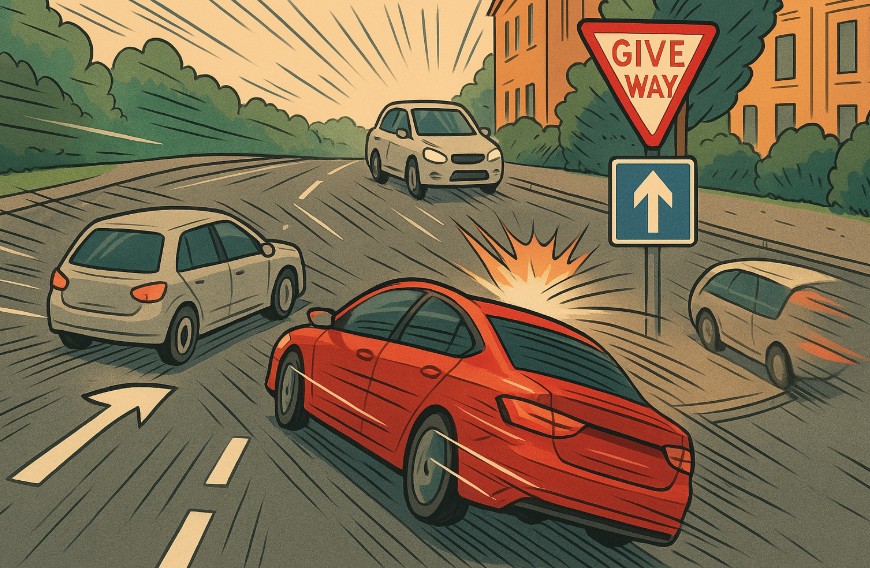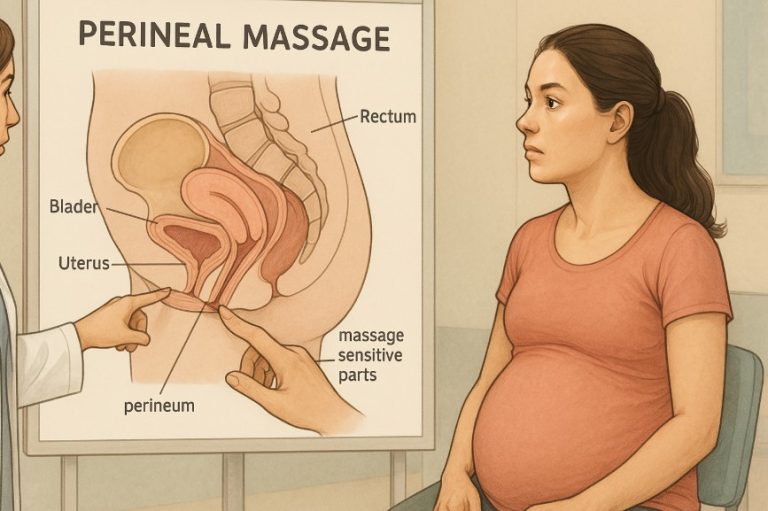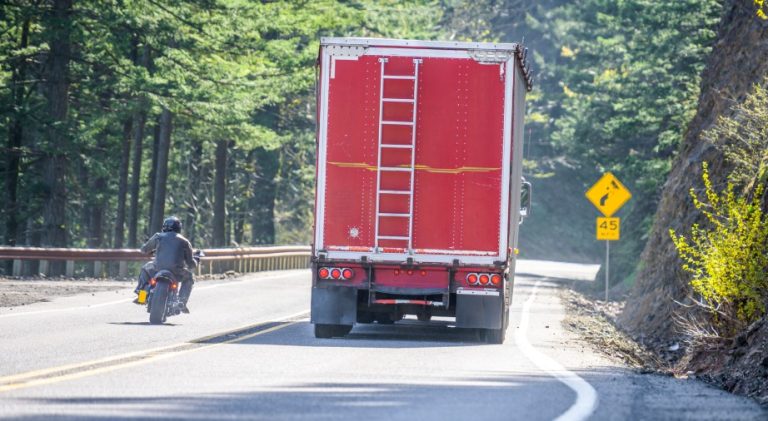Why Is It Dangerous to Overtake Near a Junction?
Did you know that overtaking near a junction significantly increases the risk of a road accident? Statistics from the Department for Transport indicate that improper overtaking is one of the leading causes of serious road traffic collisions in the UK. In particular, overtaking at or near a junction where traffic flows are unpredictable can lead to fatal consequences.
This guide explores why it’s dangerous to overtake near a junction, highlights the laws governing such actions, and provides practical advice to help drivers make safer decisions on the road.
What Are the UK Laws and Rules About Overtaking Near Junctions?

According to the Highway Code, drivers must avoid overtaking if it puts themselves or others at risk. Rule 167 specifically advises not to overtake where you might come into conflict with other road users, such as:
- Approaching a junction
- Near pedestrian crossings
- At a bend or hill crest with limited visibility
What does the Highway Code say about overtaking?
The Code clearly warns against overtaking where road layout or traffic signs indicate it’s unsafe. For example:
- Double solid white lines prohibit overtaking unless turning right or passing a stationary vehicle.
- Chevron markings often accompany prohibited zones near junctions to reinforce the restriction.
- Temporary signs during roadworks also often restrict overtaking near intersections.
How do road signs indicate overtaking restrictions?
Common UK signs include:
- No Overtaking Sign: A red circle with a black and red car side by side
- Warning signs for junctions: T-junction or crossroad icons
- “Give way” or “Stop” signs before minor junctions
These signs are not just formalities—they are placed after thorough road safety studies and accident data assessments.
What Are the Key Risks of Overtaking Near a Junction?

How does reduced visibility create danger?
Junctions, particularly those with hedges, parked vehicles, or buildings, drastically reduce sightlines. Overtaking a slow-moving vehicle may block your view of a car pulling out from a side road. The driver in that car might also have no idea you’re trying to overtake, creating a perfect storm for a side-impact crash.
What role do blind spots play in accidents?
Blind spots are enlarged when vehicles position themselves for overtaking. The overtaking vehicle may not spot a cyclist, motorcycle, or pedestrian crossing at the junction. Similarly, vehicles waiting to turn may miss a fast-moving overtaking vehicle and pull out prematurely.
Why are driver misjudgements so common at junctions?
- Speed miscalculations: Drivers often believe they have more time to overtake than they actually do.
- Assuming others will yield: Overconfident drivers wrongly assume others will wait or notice their manoeuvre.
- Misinterpreting indicators: A vehicle indicating left might still go straight; overtaking it could lead to a collision.
What are the most frequent collision scenarios?
- T-bone collisions: A car pulls out from a side road and is struck by an overtaking vehicle
- Head-on crashes: An overtaking car collides with oncoming traffic not visible due to junction layout
- Rear-end shunts: A car slows to turn, but the overtaking vehicle misjudges its speed
These accidents are not only common but often deadly due to the angles and speeds involved.
When Does Overtaking Become Most Dangerous on UK Roads?
Overtaking can be risky even under the best conditions, but it becomes especially hazardous in specific locations and situations across UK roads. These high-risk scenarios are often linked with poor visibility, complex traffic flows, and unpredictable driver behaviour—factors that become even more critical near junctions, bends, or areas of limited space.
Here’s a breakdown of some of the most dangerous locations and situations for overtaking on UK roads, with examples and insights into why they pose such significant risks:
T-Junctions: Vehicles May Emerge Unexpectedly
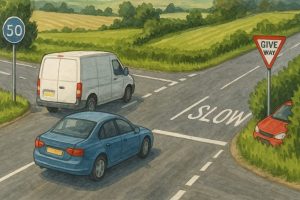
T-junctions are among the most common spots for overtaking-related collisions. A vehicle approaching from a side road may pull out thinking the road is clear, only to be blindsided by a car overtaking another vehicle.
At a T-junction:
- The driver pulling out may not see the overtaking vehicle, especially if it’s positioned beside a larger vehicle.
- The overtaking driver may miscalculate the intentions of both the vehicle being overtaken and those joining from the junction.
- Visibility is often restricted due to fences, hedges, or parked cars near the junction.
Real-world example: A driver in Kent attempted to overtake a slow-moving van near a rural T-junction. A car pulled out from the side road, resulting in a head-on collision. The overtaking driver was found at fault for unsafe overtaking in a restricted area.
Crossroads: Traffic Flow from Multiple Directions
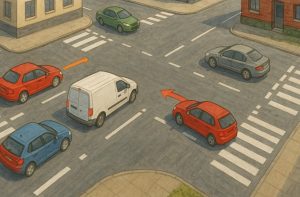
Crossroads involve traffic approaching from four directions, often with varying intentions, some drivers go straight, others turn left or right. Overtaking here is especially dangerous due to:
- Multiple potential points of conflict
- Drivers turning without signalling clearly
- Vehicles blocking the view of traffic from other directions
At a busy or poorly marked crossroads, an overtaking manoeuvre can easily place a vehicle directly in the path of oncoming or crossing traffic.
Key tip: Even if the vehicle ahead is slowing down or stopping, overtaking should be avoided. It may be preparing to turn, yield, or give way to another vehicle or pedestrian.
Roundabouts: Lane Changes and Merging Risks
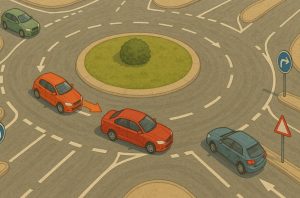
Roundabouts are designed to improve traffic flow, but they also demand constant lane discipline and awareness. Attempting to overtake just before or while entering a roundabout is highly unsafe due to:
- Sudden lane changes by other vehicles
- Multiple vehicles merging and exiting simultaneously
- Disruption to the circular traffic flow
In high-speed or multi-lane roundabouts (like those near motorways), overtaking becomes even more dangerous. Misjudging a vehicle’s exit point can result in side-swipes or last-minute braking.
Pro driving advice: Always hold your position and wait for a clear lane change opportunity. Never attempt to ‘squeeze through’ an inner lane to overtake on entry or exit.
Hidden Driveways: Limited Reaction Time
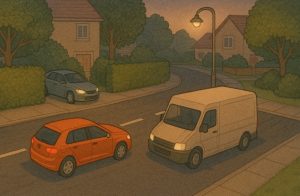
Overtaking near hidden or concealed driveways often found in suburban or rural areas poses significant danger, particularly because:
- You may not see a vehicle pulling out until it’s too late
- The vehicle exiting the driveway may not expect a car overtaking on the main road
- Reaction time is severely reduced due to the short distance between the driveway and the point of overtaking
Even if the vehicle you’re overtaking is moving slowly, the unpredictability of hidden entrances makes it unsafe.
Reminder: Driveways may not always be marked with signage, especially in older neighbourhoods. Always be cautious in residential zones or where houses are directly adjacent to the road.
Minor and Unmarked Roads: Unpredictable and Narrow
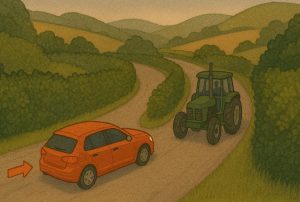
Many UK roads especially in countryside areas lack proper lane markings, warning signs, or even speed limits. These roads:
- Are often too narrow for two vehicles to safely pass side by side
- Have sharp bends or blind summits that hide oncoming traffic
- May be used by tractors, cyclists, or pedestrians without pavements
Overtaking on such roads is highly discouraged unless absolutely necessary and after thorough assessment.
Rural safety tip: On narrow country lanes, it’s often better to slow down and wait for a safer spot rather than attempting to overtake in a blind curve or before a dip.
Night Driving: Reduced Visibility and Speed Perception

At night, even familiar roads become riskier. Overtaking in darkness introduces several complications:
- Oncoming vehicles may not be visible until it’s too late
- Headlights can distort speed and distance judgment
- Road markings and signs may be harder to see
- Glare from headlights may obscure junctions or side roads
Night-time overtaking is particularly dangerous near junctions and intersections where side roads might not be illuminated.
Useful practice: Reduce your speed, use dipped beams where necessary, and avoid overtaking unless visibility is completely clear and the road is straight.
Bad Weather Conditions: Rain, Fog, Ice, and Glare
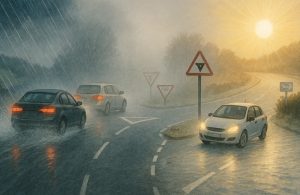
The UK is no stranger to challenging weather conditions. Rain, fog, snow, and even strong sunlight can turn overtaking into a dangerous gamble:
- Rain: Increases braking distance and causes tyre hydroplaning
- Fog: Reduces visibility to less than 100 metres, often concealing junctions
- Snow/Ice: Leads to reduced grip and poor control during acceleration or braking
- Sun glare: Especially during sunrise or sunset, can obscure road signs and other vehicles
Attempting to overtake near a junction in any of these conditions multiplies the risks and often leads to delayed response or overcorrection, resulting in serious accidents.
Professional recommendation: In adverse weather, overtaking should be avoided entirely unless you’re absolutely sure of a long, clear stretch ahead and there’s no risk of junctions nearby.
Summary: The Danger Zones
Here’s a quick summary of when overtaking becomes most dangerous on UK roads:
| Situation | Main Risk |
| T-Junctions | Vehicles pulling out unexpectedly |
| Crossroads | Traffic flow from multiple directions |
| Roundabouts | Merging traffic and lane switching |
| Hidden Driveways | Invisibility and limited reaction time |
| Minor or Rural Roads | Unmarked lanes, blind bends, narrow width |
| Night Driving | Poor visibility, misjudged distances |
| Bad Weather | Reduced control, increased stopping distance |
Understanding these zones is crucial for all drivers, particularly those new to UK roads or driving in complex urban and rural environments.
Conclusion
Overtaking near a junction isn’t simply a poor driving habit, it’s a critical safety issue with real-world consequences. Whether it’s reduced visibility, unpredictable movements, or legal penalties, the risks far outweigh the rewards.
Drivers in the UK must not only follow the Highway Code but also adopt a mindset of caution, patience, and responsibility. Recognising high-risk zones, like junctions, and resisting the urge to overtake in such areas is essential to preventing accidents.
The road ahead may seem clear for a moment, but what lies beyond the junction can change in an instant. By thinking twice before overtaking, drivers make the choice to protect themselves, their passengers, and everyone else sharing the road.
FAQs About Overtaking Near Junctions
What does the Highway Code say about overtaking at junctions?
It clearly states you must not overtake where you might come into conflict, particularly near junctions.
Are there any signs that indicate overtaking restrictions?
Yes. “No Overtaking” signs and road markings such as double white lines indicate prohibitions.
Can I overtake on a dual carriageway near a junction?
It’s allowed but only if visibility is clear and no vehicle is turning.
How can weather conditions affect overtaking safety?
They reduce visibility and traction, making it harder to stop or correct mistakes during an overtake.
What should I do if someone else overtakes me near a junction?
Let them pass. Focus on your safety, not proving a point.
What’s the penalty for overtaking dangerously near a junction in the UK?
You can be fined, get penalty points, or be banned from driving depending on severity.
How do driving instructors teach safe overtaking practices?
They focus on reading the road, judging gaps, and identifying safe conditions for overtaking.

